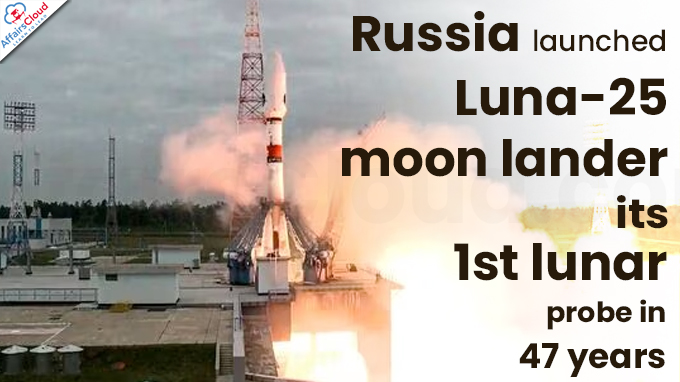
- This is Russia’s first moon mission since 1976
- Luna-25 is also the first domestically produced moon probe in modern Russian history.
Note: A moon probe is a crewless (unmanned) spacecraft used to investigate the Moon.
Aim:
With the Luna-25 mission, Russia aims to achieve the distinction of being the first country to achieve a soft landing on the lunar south pole, a region believed to hold valuable reservoirs of water ice.
- The lander is expected to touch down on the moon on August 21, 2023. Once down safe, Luna-25 will work on the moon’s south pole for at least one Earth year.
Note: Both Luna-25 and India’s Chandrayaan 3 probe are expected to achieve their respective landings around the same time and in the same general area.
Features of Luna-25:
i.The Luna-25 lander, also known as the Luna-Glob Lander, has a robotic arm to collect surface samples from the moon. It will study the composition of the moon’s polar soil and the plasma and dust contained in the very thin lunar exosphere.
ii.Luna-25 has a mass of 1.8 tons and carries 31 kilograms of scientific equipment. It will land near the lunar south pole at the Boguslavsky crater..
iii.Luna-25 is designed, built, and tested by Russian aerospace company NPO Lavochkin, and consists of 2 main parts:
- One is a landing platform outfitted with a propulsion system and landing gear, including a Doppler velocity and range meter.
- The other is an unpressurized instrument container loaded with scientific equipment, radiators, electronics, solar panels, a radioisotope heat and power source, antennas, and television cameras.
iv.The Soyuz-2 Fregat rocket carrying the Luna 25 craft is a smaller launch vehicle than those used in previous unsuccessful missions.
Instruments carried by Luna-25:
Luna-25 carries the following instruments:
- Service television system (STS-L)
- Lunar manipulator complex (LMK) with a soil intake device
- Neutron and gamma detector (ADRON-LR) to remotely look for water ice
- Infrared spectrometer (LIS-TV-RPM)
- Laser mass spectrometer (LAZMA-LR)
- Ion energy-mass analyzer (ARIES-L)
- Dust Monitor (PmL)
- Scientific information control unit (BUNI)
Functioning of Luna 25:
i.Luna-25 will use a scoop to take rock samples from a depth of up to 15 centimeters (6 inches) to test for the presence of frozen water.
ii.LMK is capable of excavating lunar regolith and delivering it directly to a LAZMA-LR. An infrared spectrometer (LIS-TV-RPM) installed on this hardware can inspect the material, assessing the prospect of finding water ice.
iii.Scientific instruments, including a range of spectrometers and imaging systems, as well as communications equipment are used to beam data back to Earth.
Key Points:
i.The south pole of the moon, is one of the least-explored areas of the moon where no spacecraft has landed. So far, the then Soviet Union, China, and the United States America (USA) have managed to land probes on the moon.
ii.As seen from the data from orbit, there are signs of ice in the soil of the Luna-25 landing area. Rough terrains make landing difficult.
iii.Luna-25 will spend 5-7 days in lunar orbit before descending near Boguslawsky Crater, which was selected as the primary landing site for the Russian Luna-Glob mission.
- 2 backup landing sites have also been identified: one to the southwest of Manzini Crater and the other to the south of Pentland A Crater.
iv.Once landed successfully, the craft will study the upper layer of the lunar regolith, appraise the ultra-thin lunar atmosphere and search for signs of water ice in the south pole region.
1976 Luna Mission of Russia:
i.The last successful Luna mission of Russia was in 1976 when the Soviet Union launched the Luna 24 probe, which successfully delivered about 6.2 ounces (170 grams) of moon samples to Earth.
ii.The Luna 24 craft landed in the Mare Crisium lunar plain and returned geographical samples that showed the presence of water on the moon.
Recent Related News:
On 3rd April 2023, NASA (National Aeronautics and Space Administration) and Canadian Space Agency (CSA) announced the 4 astronauts crew for the Artemis II Lunar mission which includes 3 United States of America (USA) nationals and one Canadian astronaut.
About Russia:
Capital– Moscow
Prime Minister– Mikhail Mishustin
Currency– Russian Ruble